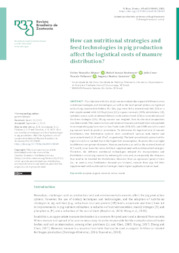How can nutritional strategies and feed technologies in pig production affect the logistical costs of manure distribution?
How can nutritional strategies and feed technologies in pig production affect the logistical costs of manure distribution?
Autoria: AFONSO, E. R.; NASCIMENTO, R. A.; PALHARES, J. C. P.; GAMEIRO, A. H.
Resumo: The objective with this study was to evaluate the impact of different swine nutritional strategies and technologies, as well as the land spread system, on logistical costs of pig manure distribution. For this, pigs were fed a conventional diet (C0) or a diet supplemented with 0.01% phytase (C1); organic minerals (40% substitution; C2); synthetic amino acids at reduced dietary crude protein levels (C3); or a combination of the three strategies (C4). All pig manure was weighed, then its chemical composition was determined. The mineral values and volume of manure produced were extrapolated to corresponding pig farm sizes in Sao Paulo state (300, 650, and 1000 sows) from real pig manure levels to produce simulations. To determine the logistical cost of manure distribution, two distribution systems were considered: vacuum tank tractor and vacuum tank truck (4.30 and 15 m³, respectively). The land spread truck system had the highest cost/hour worked due to the higher fuel consumption. However, this cost might be different over greater distances. Manure production, as well as the nutrient levels of N, P, and K, were lower for swine fed diets supplemented with nutritional technologies. Therefore, the different nutritional technologies reduced the transportation and distribution cost of pig manure by reducing the area and, consequently, the distances that need to be traveled for distribution. However, from an agronomic point of view (i.e., to meet a crop fertilization demand per hectare), manure from pigs fed diets supplemented with nutritional technologies had a higher application rate on land.
Ano de publicação: 2020
Tipo de publicação: Artigo de periódico
Unidade: Embrapa Pecuária Sudeste
Palavras-chave: Enzyme, Organic mineral, Swine, Waste
Observações
1 - Por padrão são exibidas publicações dos últimos 20 anos. Para encontrar publicações mais antigas, configure o filtro ano de publicação, colocando o ano a partir do qual você deseja encontrar publicações. O filtro está na coluna da esquerda na busca acima.
2 - Para ler algumas publicações da Embrapa (apenas as que estão em formato ePub), é necessário ter, no celular ou computador, um desses softwares gratuitos. Sistemas Android: Google Play Livros; IOS: iBooks; Windows e Linux: software Calibre.
Acesse outras publicações
Acesse a Base de Dados da Pesquisa Agropecuária (BDPA) para consultar o acervo completo das bibliotecas da Embrapa.

